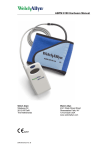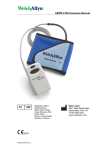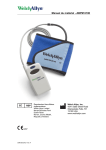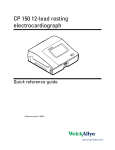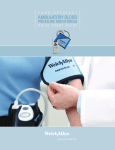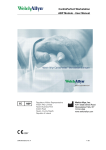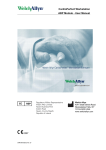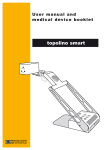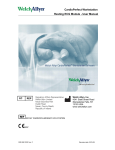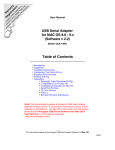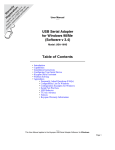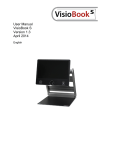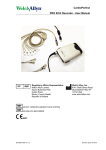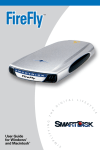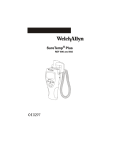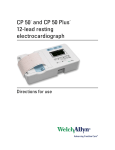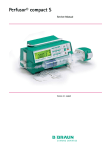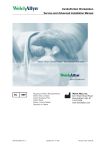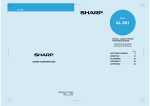Download WACP ABPM6100 Manual
Transcript
ABPM 6100 Hardware Manual European Regulatory Manager Welch Allyn Ltd. Navan Business Park Dublin Road Navan, County Meath, Republic of Ireland Tel.: +353 46 90 67700 Fax: +353 46 90 67754 0297 DIR 80012720 Ver. D Welch Allyn 4341 State Street Road Skaneateles Falls, NY 13153-0220 USA www.welchallyn.com ABPM 6100 Hardware Manual Copyright © Copyright 2010, Welch Allyn. All rights are reserved. No one is permitted to translate, reproduce or duplicate this manual or any part thereof, in any form, without prior written permission from Welch Allyn. Welch Allyn assumes no responsibility for any injury to anyone, or for any illegal or improper use of the product, that may result from failure to use this product in accordance with the instructions, cautions, warnings, or statement of intended use published in this manual. Unauthorized copying of this publication may not only infringe copyright but also reduce the ability of Welch Allyn to provide accurate and upto-date information to users and operators alike. Welch Allyn®, CardioPerfect® Workstation and SpiroPerfect® are registered trademarks of Welch Allyn. Software in this product is Copyright 2010, Welch Allyn. All rights are reserved. The software is protected by United States of America copyright laws and international treaty provisions applicable worldwide. Under such laws, the licensee is entitled to use the copy of the software provided on the original distribution medium. The software may not be copied, decompiled, reverse-engineered, disassembled or otherwise reduced to humanperceivable form. This is not a sale of the software or any copy of the software; all right, title and ownership of the software remains with Welch Allyn. The information contained in this manual is subject to change without notice. All changes will be in compliance with regulations governing manufacture of medical equipment. User responsibility This product is designed to perform in conformity with the description thereof contained in this manual and accompanying labels and inserts, when assembled, operated, maintained and repaired in accordance with the instructions provided. A defective product should not be used. Parts that are broken, plainly worn, missing or incomplete, distorted or contaminated should be replaced immediately. Should any repair or replacement become necessary, we recommend that service be performed at the nearest approved service center. The user of the product shall have the sole responsibility for any malfunction, which results from improper use, faulty maintenance, improper repair, damage or alteration by anyone other than Welch Allyn or their authorized service personnel. Accessories The Welch Allyn warranty can only be honored if you use Welch Allyn approved accessories and replacement parts. Caution DIR 80012720 Ver. D Use of accessories other than those recommended by Welch Allyn may compromise product performance. 2 / 32 ABPM 6100 Hardware Manual Warranty, Service, and Spare Parts Warranty All repairs on products under warranty must be performed or approved by Welch Allyn. Unauthorized repairs will void the warranty. In addition, whether or not covered under warranty, any product repair shall exclusively be performed by Welch Allyn certified service personnel. Assistance and Parts If the product fails to function properly or if assistance, service, or spare parts are required, contact the nearest Welch Allyn Technical Support Center. USA Latin America European Call Center United Kingdom France Germany 1-800-535-6663 (+1) 305-669-9003 (+353) 46-90-67790 Canada South Africa Australia 1-800-561-8797 (+27) 11-777-7555 (+61) 2-9638-3000 (+44) 207-365-6780 (+33) 1-55-69-58-49 (+49) 695-098-5132 Singapore Japan China (+65) 6419-8100 (+81) 3-6383-0852 (+86) 21-6327-9631 Before contacting Welch Allyn it is helpful to attempt to duplicate the problem and to check all accessories to ensure that they are not the cause of the problem. When calling, please be prepared to provide: Product name and model number and complete description of the problem The serial number of your product (if applicable) The complete name, address and phone number of your facility For out-of-warranty repairs or spare parts orders, a purchase order (or credit card) number For parts order, the required spare or replacement part number(s) Repairs If your product requires warranty, extended warranty, or non-warranty repair service, please call first the nearest Welch Allyn Technical Support Center. A representative will assist you troubleshooting the problem and will make every effort to solve it over the phone, avoiding potential unnecessary return. In case the return cannot be avoided, the representative will record all necessary information and will provide a Return Material Authorization (RMA) number, as well as the appropriate return address. A Return Material Authorization (RMA) number must be obtained prior to any return. Note Welch Allyn does not accept returned products without an RMA. Packing Instructions If you have to return goods for service, follow these recommended packing instructions: Remove all hoses, cables, sensors, power cords, and ancillary products (as appropriate) before packing, unless you suspect they are associated with the problem. Wherever possible use the original shipping carton and packing materials. Include a packing list and the Welch Allyn Return Material Authorization (RMA) number. It is recommended that all returned goods be insured. Claims for loss or damage to the product must be initiated by the sender. DIR 80012720 Ver. D 3 / 32 ABPM 6100 Hardware Manual Limited Warranty Statement Welch Allyn, Inc. warrants that the Welch Allyn CardioPerfect Workstation computer based product you have purchased meets the labelled specifications of the Product and will be free from defects in materials and workmanship that occur within 1 year after the date of purchase. Accessories used with the Product are warranted for 90 days after the date of purchase. The date of purchase is: 1) the date specified in our records, if you purchased the Product directly from us, 2) the date specified in the warranty registration card that we ask you to send to us, or 3) if you don’t return the warranty registration card, 120 days after the date on which the Product was sold to the dealer from whom you bought the Product, as documented in our records. This warranty does not cover damage caused by: 1) handling during shipping, 2) use or maintenance contrary to labelled instructions, 3) alteration or repair by anyone not authorized by Welch Allyn, and 4) accidents. If a Product or accessory covered by this warranty is determined to be defective because of defective materials, components, or workmanship, and the warranty claim is made within the warranty period described above, Welch Allyn will, at its discretion, repair or replace the defective Product or accessory free of charge. You must obtain a return authorization from Welch Allyn to return your Product before you send it to Welch Allyn’s designated service center for repair. THIS WARRANTY IS IN LIEU OF ALL OTHER WARRANTIES, EXPRESS OR IMPLIED, INCLUDING BUT NOT LIMITED TO THE IMPLIED WARRANTIES OF MERCHANTABILITY AND FITNESS FOR A PARTICULAR PURPOSE. WELCH ALLYN'S OBLIGATION UNDER THIS WARRANTY IS LIMITED TO REPAIR OR REPLACEMENT OF PRODUCTS CONTAINING A DEFECT. WELCH ALLYN IS NOT RESPONSIBLE FOR ANY INDIRECT OR CONSEQUENTIAL DAMAGES RESULTING FROM A PRODUCT DEFECT COVERED BY THE WARRANTY. DIR 80012720 Ver. D 4 / 32 ABPM 6100 Hardware Manual Table of contents 1. OVERVIEW ...........................................................................................................................6 2. ABPM 6100 MONITOR .......................................................................................................10 2.1 2.2 3. Introduction........................................................................................................................10 Operation...........................................................................................................................11 INTERFACE ........................................................................................................................13 3.1 3.2 3.3 3.4 3.5 3.6 3.7 3.8 Preliminary Directive..........................................................................................................13 Prior to Hook-up ................................................................................................................13 Sizing.................................................................................................................................13 Traditional Cuff Placement ................................................................................................14 Sleeve Cuff Placement......................................................................................................14 Office Readings .................................................................................................................16 Regular Runs.....................................................................................................................16 Data ...................................................................................................................................17 4. KEYSPAN USB TO SERIAL ADAPTER INSTALL............................................................19 5. MAINTENANCE AND CLEANING .....................................................................................22 6. CALIBRATION CHECK ......................................................................................................23 7. SPECIFICATIONS...............................................................................................................25 8. TROUBLESHOOTING AND ERROR CODES ...................................................................27 8.1 8.2 9. Error Codes .......................................................................................................................27 Troubleshooting.................................................................................................................28 GUIDANCE AND MANUFACTURER’S DECLARATIONS................................................29 DIR 80012720 Ver. D 5 / 32 ABPM 6100 Hardware Manual 1. Overview The purpose of this manual is to provide an overview of information that you will need to safely and effectively use the ABPM 6100 monitor. Information about the ABP Workstation Software is available in the ABP Workstation software manual. Make sure that you familiarize yourself with all of the safety precautions listed in this chapter before attempting to use either device or the software. Intended Use PROPER USE OF THE ABPM 6100 MONITORS: 1. The ABPM monitors are intended for use by a trained medical practitioner. Interpretation of blood pressure measurements should always be performed by a physician. 2. The reliability of all the monitors and the software depend upon conformance with the operation and maintenance instructions in this manual. 3. The ABPM 6100 monitors are designed for use with patients with normal sinus rhythms. 4. Measurement accuracy for the ABPM 6100 monitors may be affected by position of the subject, physical conditions, movement, and use outside of the operating instructions contained in this manual. Conventions Caution: consult accompanying documents Identifies information within the manual to avoid injury Serial Number Defibrillation-proof type BF applied part Meets essential requirements of European Medical Device Directive 93/42/EEC Manufacturer IPXØ No protection against the ingress of liquids Identifies the battery Do not dispose of this product as unsorted municipal waste. Prepare this product for reuse or separate collection as specified by Directive 2002/96/EC of the European Parliament and the Council of the European Union on Waste Electronic and Electrical Equipment (WEEE). If this product is contaminated, this directive does not apply. For more specific disposal information, see www.welchallyn.com/ weee, or contact Welch Allyn Customer Service. DIR 80012720 Ver. D 6 / 32 ABPM 6100 Hardware Manual EMC Framework of Australia Certified to: CAN/CSA STD C22.2 NO. 601.1 Conforms to: IEC 60601-1, 60601-1-2, UL STD 2601-1 Recycle DIR 80012720 Ver. D 7 / 32 ABPM 6100 Hardware Manual Safety and Effectiveness Warnings and Cautions Safety and Effectiveness Warnings Make sure that you are familiar with all Safety and Effectiveness considerations before using the ABPM 6100 monitor. IMPORTANT WARNINGS The following warnings apply to the ABPM 6100 Ambulatory Blood Pressure Monitors: Warning The ABPM 6100 has not been designed for use with high frequency (HF) surgical equipment and does not protect against hazards to the patient. Ensure the location of the ABPM 6100 provides maximum separation away from all sources of high-frequency energy. DO NOT use the ABPM 6100 monitor in the presence of flammable anaesthetics due to risk of explosion. DO NOT immerse the ABPM 6100 monitor in any fluid, place any fluid on the monitor, or attempt to clean either monitor with liquid detergents or cleaning agents. If any of these instances occurs, return the unit to an authorized Welch Allyn Service Center. The ABPM 6100 may be cleaned with a damp cloth only. DO NOT remove the ABPM 6100 covers. Neither unit contains any serviceable parts. DO NOT use the monitor if it has failed any diagnostic self-test. DO NOT use the unit if it displays a pressure greater than zero when no cuff is attached. This could lead to inaccurate measurements. DO NOT attach the cuff to a limb being used for intravenous infusions. This may cause the infusion to be blocked and cause the patient harm. DO NOT substitute any component for those supplied by Welch Allyn. DO NOT attempt to repair the unit yourself. Repairs should be performed only by authorized Welch Allyn Service Centers DO NOT attach the cuff to a patient while the PC Serial Connector is attached to the unit. DIR 80012720 Ver. D 8 / 32 ABPM 6100 Hardware Manual Caution The ABPM 6100 is intended to be used as an ambulatory blood pressure recorder that is sent home with the patient to record their blood pressure over a 24 hour period. It is used to gather trending information in non-critical settings. It is not intended to provide clinicians with real time monitoring of patients in an ER or critical care environment. The ABPM 6100 monitors are not intended for use on pregnant women or neonates. The ABPM 6100 units may not yield accurate blood pressure measurements for patients experiencing moderate to severe arrhythmias. Check to ensure that the operation of the unit does not result in prolonged impairment of the patient’s circulation. Instruct the patient to manually remove the cuff if it fails to deflate within three minutes. Avoid compression or restriction of pressure tubes. The ABPM 6100, the cuff and tubing are defibrillator protected. The ABPM 6100 has no specific precautions during defibrillation, and defibrillation has no effect on the ABPM 6100 monitor. DIR 80012720 Ver. D 9 / 32 ABPM 6100 Hardware Manual 2. ABPM 6100 Monitor 2.1 Introduction The ABPM 6100 Unit is worn by the patient in a belt or shoulder strap and is connected to a cuff, which is wrapped around the non-dominant arm. ABPM 6100 inflates the cuff at preprogrammed intervals throughout the day and measures blood pressure using the oscillometric method, which senses the cessation of pressure waves in the artery when occluded by pressure in the cuff. Heart rate can also be measured using the frequency of pressure waves. Blood pressure measurements made by the ABPM 6100 are equivalent to those made by a trained observer using the cuff/stethoscope auscultation method within the limits prescribed by the American National Standard, Electronic or Automated Sphygmomanometers. To get the most out of the ABPM 6100, you should read this section of the manual thoroughly. You will also need to read and understand the ABP Workstation software manual to properly interface the ABPM 6100 monitor with the software. Checklist Check to make sure that the ABPM 6100 package contains the following: - ABPM 6100 Monitor, PC Interface Cable, Belt and Shoulder Strap, - Warranty Card, Patient Diary and Cuff Anchors pads - Keyspan serial adapter including CD - Adult Size Cuff - 4 AA Batteries - ABPM 6100 hardware & ABP Workstation Software Manual CD - Monitor Pouch Caution Substitution of a component different from that supplied might result in measurement error! Remember to fill out your warranty registration card and send it to Welch Allyn as soon as possible. Report any damaged or missing components to your authorized Welch Allyn representative. DIR 80012720 Ver. D 10 / 32 ABPM 6100 Hardware Manual 2.2 Operation This section provides a brief overview of the ABPM 6100 unit, how to load the batteries, and the unit controls. The ABPM 6100 features a simple design. One Start/Stop button functions as the primary control. The LCD (liquid crystal display) displays easy-to-read information. The ABP Workstation Software allows you to program the unit before the study and retrieve data after the study. A single air hose connector allows you to connect the cuff to the unit. The Start/Stop button allows you to perform the following functions: - Turn the unit On when it is Off. - Put the unit into Study Mode and take a reading when the unit is in Normal Mode. The time will flash on the LCD when the unit is in Normal Mode. - Turn the unit Off from Normal or Study mode when the button is pressed and held until the unit beeps five times (approximately five seconds) - Initiate a reading when the unit is in Study Mode. - Abort a reading and deflate the cuff if pressed when the unit is taking a reading. On the back of the ABPM 6100 monitor, a label lists the model and serial number of the unit. The first four digits of the serial number correspond to the year that the unit was manufactured. The battery compartment is on the back of the unit. The connector on the bottom of the unit allows you to connect the unit to a PC using the PC Interface Cable. Batteries The ABPM 6100 monitor requires 2 AA batteries. Batteries are installed into the ABPM 6100 unit in the battery bay located at the back of the unit. If rechargeable batteries are used, please refer to the manufacturer’s guidelines for safe use and adequate maintenance. When batteries are properly loaded and first installed, the unit will display the following: - Incrementing dashes for 2 seconds. - Two sets of numbers, the first set of three being the Software Version - Battery voltage displayed for 2 seconds (prior to the voltage, the letter “b” will present) - Three quick audible beeps. - The number of BP readings (if any) in memory along with a flashing printer symbol for 3 seconds (the number of readings may not be displayed if the batteries were removed before the unit was turned off) - One long audible beep. - Displays flashing time for 20 seconds (after 20 seconds the units turns itself off and goes into Sleep Mode to conserve battery life) DIR 80012720 Ver. D 11 / 32 ABPM 6100 Hardware Manual At this point the unit will be ready to upload a BP Study. When the unit is turned on subsequently, the unit will display the following: - Three quick audible beeps. - The number of BP readings (if any) in memory along with a flashing printer symbol for 3 seconds. - One long audible beep. - Displays flashing time for 20 seconds (after 20 seconds the units turns itself off and goes into Sleep Mode to conserve battery life) The LCD Display The LCD displays the following information depending upon the state that the unit is in: - The time is displayed whenever the unit is in Normal Mode and ready for an action. - A sun symbol is displayed whenever the buzzer is on (usually during the day). - A Crescent Moon symbol is displayed when the buzzer is off (usually during programmed sleeping periods). - A clock is displayed whenever the unit is in Study Mode. - A battery symbol is displayed whenever the battery voltage is low and the batteries need to be replaced. Care needs to be taken to avoid removing the batteries from the unit for any length greater than 15 minutes. Even though the battery level may be too low to actuate the pumps, there will be enough charge to maintain the internal clock and patient readings for many months. When the ABPM 6100 is not being used for more than 3 months, care needs to be taken to remove the batteries. Before the batteries are removed, download all data or the data will be lost. - A printer symbol indicates that the unit contains readings in the memory. DIR 80012720 Ver. D 12 / 32 ABPM 6100 Hardware Manual 3. Interface This section describes how to connect the ABPM 6100 monitor to the patient for monitoring sessions. 3.1 Preliminary Directive Advise the patient to: - Wear a loose fitting blouse or shirt. - Avoid wearing long sleeved sweaters or dresses during monitoring period. - Avoid swimming, showering, or bathing during monitoring. - Avoid operating heavy equipment or power tools, as vibrations may functionally disrupt the monitor. 3.2 Prior to Hook-up Before hooking the ABPM 6100 unit up to the patient, make sure you have performed the following tasks: - Be sure the patient name and ID are on the diary and logged separately to avoid confusion with other patient data. - Make sure that the ABPM 6100 monitor contains new or charged batteries. - For new studies, make sure that all old data has been downloaded to the ABP Workstation Software and the ABPM 6100 monitor’s memory has been cleared out. - Make sure that the proper Study parameters have been written from the ABP Workstation Software to the unit. - Seat the patient comfortably. If the patient has long sleeves, have the patient remove his or her shirt. Ask the patient which is the non-dominant arm. You will place the cuff on this arm. 3.3 Sizing Since correct cuff sizing is vital to the accuracy of monitoring data, make sure that you read this section carefully and understand all of the information contained herein before sizing the cuff to the patient. USING THE CUFF RANGE MARKS Each cuff has two range marks. To size using the range marks, wrap the cuff around the patient’s non-dominant arm. If the edge of the cuff falls within the range marks, the cuff is the correct size for the patient. If the cuff edge does not fall within the range marks, try a different size cuff. USING THE SIZING TABLE For proper cuff selection, find the circumference of the patient’s upper arm and refer to this cuff sizing chart. DIR 80012720 Ver. D 13 / 32 ABPM 6100 Hardware Manual Cuff Size Pediatric Cuff Small Adult Cuff Adult Cuff Soft disposable cuffs Part 5082-94-3 15.8-21.3 cm Part 5082-95-3 20.0-27 cm Part 5082-96-3 25.3-34.4 cm Adult Plus Cuff NA Large Adult Cuff Part 5082-97-3 32.0-43.4 cm 3.4 Arm Circumference Reusable sleeve cuffs NA Part 101340 18-27 cm Part 101341 25-35 cm Part 101342 33-40 cm Part 101343 39-46 cm Traditional reusable sleeve cuffs Part 6100-10 16.0 – 21.8 cm Part 6100-11 21.1 – 26.6 cm Part 6100-12 25.4 – 34.3 cm Part 6100-13 27.0 – 42.0 cm Part 6100-14 34.3 – 48.2 cm Traditional Cuff Placement Proper cuff placement is very important to achieve accurate blood pressure measurements. Follow these instructions to ensure the cuff is accurately placed on the patient. Traditional cuff 1. Wrap the cuff snugly around the patient’s non-dominant arm as shown in the picture, making sure that the air hose leading from the cuff is not crimped or damaged. The cuff may be worn over a thin shirt without compromising the readings. 2. Attach an adhesive cuff anchor to the clear tab on the cuff, and fasten the cuff anchor to the patient. Note: Make sure that the parameters have been written to the ABPM 6100 monitor before proceeding. The monitor should be in sleep mode. 3. Attach the tubing from the ABPM 6100 monitor to the cuff tubing and insert the ABPM 6100 monitor into the monitor pouch. Attach the pouch to the shoulder strap or the belt, depending upon which is more comfortable to the patient. Be sure to allow enough slack for the patient to move comfort ably. 3.5 Sleeve Cuff Placement Using an incorrect cuff size could result in erroneous and misleading blood pressure measurements. DIR 80012720 Ver. D 14 / 32 ABPM 6100 Hardware Manual Sleeve cuff Step 1: To determine the correct cuff size for your patient, follow these simple steps: 1. To find the right sized cuff, wrap the cuff around the patient’s upper arm without sliding the arm through the sleeve. 2. Use the color-coded RANGE indicator on the inside of the cuff and the bold INDEX marker to check that the arm circumference falls within the cuff range. 3. If the arm is within range, this cuff size is correct for your patient. If the measurement is outside the RANGE indicator, select a new cuff size as indicated by color. Step 2: Applying the Cuff 1. To apply the Welch Allyn ABPM 6100 cuff, simply slide the sleeve up the patient’s arm, ensuring the color size indicator is at the top of the cuff. The cuff should be midway between the elbow and shoulder. 2. Be sure the ARTERY indicator is over the patient’s brachial artery, between the biceps and triceps muscles (see illustration showing left arm placement). 3. Wrap the cuff snugly around the patient’s upper arm. 4. Take the initial BP reading and ensure hookup is working. 5. Refer to figures 1, 2 and 3 on inside flap for an illustrated overview. Step 3: Prepare the Patient 1. Preparing the patient is the most important step in obtaining an accurate, reliable blood pressure measurement. 2. Review the following instructions with your patient: Avoid excess movement during readings Relax the instrumented hand, slightly away from the body Avoid hand movement Avoid flexing muscles during the reading Do not remove the cuff between readings DIR 80012720 Ver. D 15 / 32 ABPM 6100 Hardware Manual 3.6 Office Readings Once the ABPM 6100 monitor has been properly attached to the patient and the PC interface cable has been removed from the unit, it is important and necessary to perform office readings in order to make sure that the unit is functioning properly and does not cause discomfort to the patient. The ABPM 6100 monitor will not begin regular runs until at least one manually initiated reading has been taken. Follow these instructions to perform an Office Reading: 1. If the unit is in Sleep Mode (no display on the LCD), press the Start/Stop button to “wake” the unit. 2. Press the Start/Stop button again to initiate a manual reading. This will cause the cuff to inflate and a reading to be taken. 3. Record the readings that are taken in the office as office readings into the patient diary, so that information can be taken into account in the analysis of the study. This is also a good opportunity to instruct the patient about the use of the patient diary. If the Start button is disabled when the parameters are written to the unit (thus disallowing initiation of manual readings), the ABPM 6100 monitor still allows you to manually initiate measurement for up to 30 minutes after parameters have been written to the unit and the unit has been “woken” from Sleep Mode. This allows you to initiate manual office readings even if you do not wish the patient to be able to initiate readings. 3.7 Regular Runs Once at least one manual office reading has been taken, regular readings will initiate based upon the interval configured for the first time period. BEFORE THE PATIENT LEAVES Make sure of the following before the patient leaves the office: The belt or shoulder strap and pouch are positioned comfortably. The Start/Stop button is accessible to the patient. (Even if the Start button is disabled in the Study Parameters, the Start/Stop button will still allow the patient to cancel a reading.) The ABPM 6100 monitor is concealed according to the patient’s wishes. Remember the patient’s comfort and ability to perform normal tasks can significantly impact the relevance of monitoring data. If the display is on, briefly review with the patient how to read the data. Explain to the patient the kind of information required in the Patient Diary. If the Start button is enabled, explain to the patient that he or she has the option to initiate readings using the Start/Stop button. OTHER INSTRUCTIONS FOR PATIENTS The patient should also be advised of the following: Pressing the Start/Stop button during a reading will cancel that reading and deflate the cuff regardless of whether the Start button is set to On or Off in the Study Parameters. Advise the patient to undress carefully at bedtime, using caution not to disconnect the hose from the monitor. Placing a pillow over the monitor during sleep will reduce any electrostatic hum from the ABPM 6100 unit. All data is stored internally after deactivation. DIR 80012720 Ver. D 16 / 32 ABPM 6100 Hardware Manual PATIENT DO’S AND DON’TS: Finally, familiarize the patient with the following list of do’s and don’ts: Do: Wear a loose fitting blouse or shirt. Record time, symptom/mood and activity/position in the patient diary. Activate a reading (if the Start/Stop button is activated) at the first sign of symptoms. Remain motionless during readings. Keep vehicle driving and travel to a minimum. Bring diary upon return. Don’t: Remove the cuff. Get the monitor wet. Use power tools or heavy equipment during a reading. Remove the batteries from the unit. Wear long-sleeved sweaters or dresses during monitoring period. Swim, shower, or bathe during monitoring. Operate heavy equipment or power tools, as vibrations may functionally disrupt the monitor. 3.8 Data After the ABPM 6100 monitor is disconnected from the patient, you will need to reconnect the monitor to the PC in order to read data from the unit. To reattach the monitor to the PC, simply locate the monitor (smaller) end of the PC Interface Cable and insert it into the communications port located at the bottom of the unit (the PC end of he PC Interface Cable should still be attached to the PC). If your computer doesn’t have a COM port you need to install the Keyspan Highspeed USB to serial adapter (USA 19H), please refer to section 4. for more details. Reading Data from the Unit Whenever data is contained in the unit, it can be read from the unit into the ABPM 6100 software. The ABP Workstation software will then allow you to view the data and configure reports. See the ABP Workstation software manual for more information. To read data from the unit: 1. Make sure that the ABPM 6100 monitor is properly connected to the PC. 2. Open the ABP Workstation software. 3. Select the Patient Study that you wish to read data into by clicking the representative date under the appropriate patient name. If no Patient Study has been created yet, create a Patient Study by following the instructions in the Creating a New Patient Study section of the ABP Workstation software manual. 4. Follow the instructions in the ABP Workstation Software Manual chapter 2.3 5. Within a few seconds, the data will be retrieved from the unit. If the Patient ID in the Unit does not match the Patient ID in the ABP Workstation software Patient Study, a message will appear stating, “Patient ID in unit and study do not agree. Use ID in unit?” Select Yes to use the Patient ID currently stored in the unit; select No to use the Patient ID in the ABP Workstation software. The data from the unit will now be stored in the ABP Workstation software. If you receive an error message when you try to read data from the unit, make sure the PC Interface Cable is properly attached to both the monitor and the PC and repeat the Read Data from Unit command. DIR 80012720 Ver. D 17 / 32 ABPM 6100 Hardware Manual See the ABP Workstation software manual for instructions on using the software and the data handling and reporting options it offers. DIR 80012720 Ver. D 18 / 32 ABPM 6100 Hardware Manual 4. Keyspan USB to Serial adapter Install If your computer doesn’t have a COM port you need to install the Keyspan Highspeed USB to serial adapter (USA 19H). The purpose of this section is to assist with the Install of the Keyspan Highspeed USB to Serial Adapter (USA19H) and determining the COM port assigned. If you are having difficulty contact Technical Support, see page 3. Note: Before inserting the Adapter into the USB port you must first install the software. 1. Insert the CD into the CD drive and close the door. The CD should auto run and show the menu below. 2. Click “Install Software” 3. Click “Install Keyspan Serial USB Adapter Software” DIR 80012720 Ver. D 19 / 32 ABPM 6100 Hardware Manual 4. Click “Next” 5. Click “Yes” if you agree with the license agreement. 6. Click “Next” 7. Click “Finish” 8. Insert the Keyspan Adapter into an available USB port. 9. The driver will load automatically after few seconds. When the light on the adapter flashes at a constant rate (~1 sec interval) the device is ready. Note: If you plan to remove this on a regular basis. Mark the port that it is plugged into. If you plug it into a different port it will install a different COM port and the program may not function correctly. 10. To determine which COM port was assigned by the Keyspan Serial Assistant assigned to the device click “Start” DIR 80012720 Ver. D 20 / 32 ABPM 6100 Hardware Manual 11. Navigate as shown above and click “Keyspan Serial Assistant” 12. In the example above “COM4” was assigned to the adapter. Make note of which COM port yours assigned and set this as the COM port for connection to your device in the CardioPerfect Workstation. DIR 80012720 Ver. D 21 / 32 ABPM 6100 Hardware Manual 5. Maintenance and Cleaning Preventative maintenance should be routinely performed to ensure the safe and efficient operation of the ABPM 6100 monitor. In addition, the monitor should be cleaned after each use. Maintenance The following inspections of the ABPM 6100 unit should be performed on a regular basis: The PC connection cable should be inspected for any cracks, exposed wires or other damage. The monitor itself should be visibly inspected for any signs of damage. Pneumatic tubing should be inspected for any cracks, fraying, or kinks. Do not remove any covers or break the warranty seal while inspecting the unit. If any signs of damage are detected, do not use the ABPM 6100 monitor. It should be sent to an authorized Welch Allyn service center. See the Service and Warranty section of this manual for a list of authorized Welch Allyn service centers. Cleaning CLEANING THE ABPM 6100 UNIT IMPORTANT: The ABPM 6100 cannot be sterilized. DO NOT immerse the monitor in any fluid or use liquid detergents, cleaning agents, or solvents to clean it. If the unit is immersed in any liquid, do not use the unit again. The unit should be sent to an authorized Welch Allyn service center. The ABPM 6100 unit should be cleaned after every use. Use a soft, damp cloth to remove any dirt and dust from the unit. DISINFECTING THE CUFF A mild disinfectant solution should be used on the cuff. Do not remove the nylon bladder inside of the cuff during this process. If you are using a Welch Allyn sleeve cuffs, you can easily remove bladders to aid in washing and disinfecting. Sleeve cuffs are machine washable. DIR 80012720 Ver. D 22 / 32 ABPM 6100 Hardware Manual 6. Calibration Check Welch Allyn recommends that the calibration of the ABPM 6100 monitor be verified annually by the user using the following procedure: 1. With the ABPM 6100 unit already powered up, remove one of the AA batteries from the battery compartment. Then immediately replace the battery back in its proper orientation, which will result in the unit to start the power up cycle. 2. While the LCD is displaying dashes, press and hold down the Start/Stop button. The unit will display the software version, the battery voltage, followed by a click as the valves are closed. When the process is finished, a pressure value will be displayed on the LCD and the unit is ready to have the calibration checked. 3. Disconnect the ABPM 6100 monitor cuff assembly from the unit 4. Attach the appropriate end of ABPM 6100 Y-connector (Welch Allyn Part #6100-25) to the monitor. Attach a cuff to the appropriate end of the Y-connector, and wrap around a suitably sized can or bottle. This acts as the reservoir for the unit. Connect the third leg of the Y-connector to a high quality, known pressure standard1. Refer to the calibration figure below for a sketch of the test set up. 5. Pressurize gauge to 250 mmHg and compare against pressure standard (see Note below). If the unit does not meet the required calibration, unit needs to be returned to Welch Allyn for calibration or repair. 6. Bleed pressure down no faster than 10 mmHg per second, stopping to check the pressure at 250, 200, 150, 100, and 50 mmHg 7. When finished, remove one of the AA batteries from the battery compartment. Then immediately replace the battery back in its proper orientation, which will cause the unit to start the power up cycle. Cuff Wrapped Around Cylinder Typical Office Manometer Attach to Init Note: Your ability to measure the accuracy of the ABPM 6100 depends upon the sensitivity of the pressure standard you use for the calibration procedure. If using a manometer (mercury column or aneroid gauge) rated at ± 3.0 mm Hg, you will be able to determine the accuracy of the unit being tested to within ± 6.0 mm Hg. If using a device (e.g., digital pressure standard) rated at ± 1.0 mm Hg, you will be able to determine the accuracy of the unit being tested to within ± 4.0 mm Hg. DIR 80012720 Ver. D 23 / 32 ABPM 6100 Hardware Manual Welch Allyn recommends using the most sensitive pressure standard possible when performing calibration checks. A Setra Pressure Meter 2270-01, which is calibrated for ± 0.1 mm Hg, works well for this application.In the Federal Republic of Germany: In accordance with Med BetreibV, the ABPM must be returned every 2 years to instrumentation control for calibration certification. DIR 80012720 Ver. D 24 / 32 ABPM 6100 Hardware Manual 7. Specifications This section provides the unit specifications for the ABPM 6100 ambulatory blood pressure monitor. Power Requirements: Two “AA” alkaline batteries or high capacity rechargeable batteries (NimH). Dimensions: 124 x 70 x 33 mm (approximate). Weight: 270g (including batteries, approximate). Environmental Operating Condition: Atmospheric Pressure Range of 700 HPA to 1060 HPA Protection against electric shock: Internally powered, Type BF Operating Ambients: Temperature: 10°C (50°F) to 50°C (122°F). Humidity: 20% to 95% RH non-condensing. Storage Ambients: Temperature: -20°C (-68°F) to 70°C (158°F). Humidity: 15% to 95% RH non-condensing. Altitude: -170 to 1,700 meters Gauging Ranges: Systolic Blood Pressure: 60 to 250 mmHg Diastolic Blood Pressure: 25 to 200 mmHg Maximum Inflation: 270 mmHg Heart Rate: 40 to 200 bpm Memory: Up to 250 readings using Alkaline batteries Up to 110 reading using rechargeable NimH Method of Measurement: Oscillometric with step deflation. Accuracy: ± 3 mmHg International Standards: EN 60601-1-1:2001 ; Medical electrical equipment – Part 1-1: General requirements for safety. Collateral standard: Safety requirements for medical electrical systems Specific requirements for the protection against hazards of ignition of flammable anesthetic mixtures and to control the risk of fire (Fire prevention) EN 60601-2-30:2000 ; Medical electrical equipment – Part 2-30: Particular requirements for the safety, including essential performance, of automatic cycling non-invasive blood pressuring monitoring equipment EN 60601-1-2:2001 ; Medical Electrical Equipment – Part 1-2: General requirements for safety. Collateral Standard: Electromagnetic compatibility – requirements and tests EN 1060-1:1996 ; Specification for Non-invasive sphygmomanometers – Part 1. General requirements EN 1060-3:1997 ; Non-invasive sphygmomanometers – Part 3: Supplementary requirements for electro-mechanical blood pressure measuring systems AAMI SP 10 ES1 Category C: 1992 (battery powered) Electronic or automated sphygmomanometers Calibration: Minimally, once per year Safety System: Maximum Inflation pressure limited to 300 mmHg. Auto safety release valve for power failure. DIR 80012720 Ver. D 25 / 32 ABPM 6100 Hardware Manual Maximum BP measurement time limited to less than 180 seconds. Data Connector: Stereo mini-plug headphone type connector. Operator Control: 1-button control and LCD. Automatic Measurement Intervals: Programmable up to four separate time periods at 5 to 120 minute intervals. 8. Classification Protection against electric shock: Internally powered, Type BF Protection against the ingress of liquids: IPXØ, per IEC 60529 9. Discarding the Equipment Discard the old battery appropriately. • In the USA, call 1800-SAV-LEAD for instructions on recycling it. • International users, contact your local authorities concerning recycling. • Discard the ABPM 6100 and accessories according to local laws. Do not dispose of this product as unsorted municipal waste. Prepare this product for reuse or separate collection as specified by Directive 2002/ 96/EC of the European Parliament and the Council of the European Union on Waste Electronic and Electrical Equipment (WEEE). If this product is contaminated, this directive does not apply. For more specific disposal information, see www.welchallyn.com/weee, or contact Welch Allyn Customer Service. DIR 80012720 Ver. D 26 / 32 ABPM 6100 Hardware Manual 10. Troubleshooting and Error Codes 10.1 Error Codes The ABPM 6100 monitor displays error codes whenever an error situation is encountered. Error codes will display on the unit’s LCD. Error codes that apply to a specific reading will also display in the ABP Workstation Software when the data is read from the unit. The following table explains error codes generated by the ABPM 6100 monitor along with possible solutions for each error code. Error Code 2 Description Weak or no oscillometric signal Artifact/Erratic Oscillometric Signal 3 Exceeded retry count (4 inflate attempts) 4 Exceeded measurement time limit (120 seconds) 85 Reading aborted (blocked valves or pneumatics) 1 86 87 88 89 90 91 97 98 99 Reading aborted (manual abort) Reading aborted (inflate time-out or air leak) Reading aborted (safety time-out) Reading aborted (cuff overpressure) Service Required (power supply out-of-range or other hardware problem) Service Required (safety override fitted or autozero out-of-range) Service Required Transducer out-of-range Service Required (A/D outof-range) Service Required (EEPROM calibration data CRC failure) Solution Check cuff position and cuff tightness Instruct patient to remain still during reading. Try reading again. Instruct patient to remain still during reading. Try reading again. Check air hose connections and make certain cuff is tight enough. Check air hose connections and make certain air tubing is not crimped. Push Start/Stop button to restart reading Check air hose and cuff Push Start/Stop button to restart reading. If problem persists, return for servicing.* Check air hose for blockage or kinking Replace batteries. If problem persists, return for servicing.* Push Start/Stop button to retry reading. If problem persists, return for servicing.* Return for servicing* Return for servicing* Unit needs to be recalibrated. Return for servicing.* The codes mentioned above, are the codes as shown on the device display. Please refer to the CPWS ABP Software manual for the codes as used by the software. DIR 80012720 Ver. D 27 / 32 ABPM 6100 Hardware Manual * Always return ABPM 6100 monitor to an authorized service center for repairs. Unauthorized service will void all warranties. 10.2 Troubleshooting The following table contains a list of troublesome scenarios accompanied by suggestions for problem solving. Trouble Cycle starts but cuff will not fully inflate Blood Pressure readings are not displayed during Regular Runs. Patient activation button does not initiate readings while in the Regular Run mode. Time Regular Runs do not initiate Blood Pressure readings are failing with error codes being displayed DIR 80012720 Ver. D Response to Trouble Ensure a connection with the ABPM 6100 monitor is secure and check bladder for leak; replace if needed. Replace batteries and try again. Verify that the display setting is ON in the Basic Parameters menu. Verify that Start Button is ON in the Basic Parameters menu. Make sure that the time period is not set for MAN (manual) operation. Refer to the Error Codes section ABP Workstation Software manual. 28 / 32 ABPM 6100 Hardware Manual 11. Guidance and Manufacturer’s Declarations CAUTION The ABPM6100 needs special precautions regarding EMC and needs to be installed and put into service according to the following EMC information provided. Portable and mobile RF communications equipment can affect the ABPM6100. Electromagnetic Emissions The ABPM6100 is intended for use in the electromagnetic environment specified below. The customer or the user of the ABPM6100 should assure that it is used in such an environment. Emissions test RF emissions Compliance Group 1 CISPR 11 RF emissions Electromagnetic environment – guidance The ABPM6100 uses RF energy only for its internal function. Therefore, its RF emissions are very low and are not likely to cause any interference in nearby electronic equipment. Class B CISPR 11 Harmonic emissions n.a. IEC 61000-3-2 Voltage fluctuations/ flicker emissions The ABPM6100 is suitable for use in all establishments, including domestic establishments and those directly connected to the public low-voltage power supply network that supplies buildings used for domestic purposes. n.a. IEC 61000-3-3 DIR 80012720 Ver. D 29 / 32 ABPM 6100 Hardware Manual Electromagnetic Immunity The ABPM6100 is intended for use in the electromagnetic environment specified below. The customer or the user of the ABPM6100 should assure that it is used in such an environment. Immunity test IEC 60601 test level Compliance level Electromagnetic environment – guidance 6 kV contact 6 kV contact IEC 61000-4-2 8 kV air 8 kV air Electrical fast transient/burst ±2 kV for power supply lines n.a. Mains power quality should be that of a typical commercial or hospital environment. n.a. Mains power quality should be that of a typical commercial or hospital environment. n.a. Mains power quality should be that of a typical commercial or hospital environment. If the user of the ABPM6100 requires continued operation during power mains interruptions, it is recommended that the ABPM6100 be powered from an uninterruptible power supply or a battery. 3 A/m Power frequency magnetic fields should be at levels characteristic of a typical location in a typical commercial or hospital environment. Electrostatic discharge (ESD) IEC 61000-4-4 ±1 kV for input/output lines Surge 1 kV differential mode IEC 61000-4-5 2 kV common mode Voltage dips, short interruptions and voltage variations on power supply input lines <5 % UT (>95 % dip in UT) for 0,5 cycle IEC 61000-4-11 Floors should be wood, concrete or ceramic tile. If floors are covered with synthetic material, the relative humidity should be at least 30 %. 40 % UT (60 % dip in UT) for 5 cycles 70 % UT (30 % dip in UT) for 25 cycles <5 % UT (>95 % dip in UT) for 5 sec Power frequency (50/60 Hz) magnetic field 3 A/m IEC 61000-4-8 NOTE UT is the a.c. mains voltage prior to application of the test level. DIR 80012720 Ver. D 30 / 32 ABPM 6100 Hardware Manual Electromagnetic Immunity The ABPM6100 is intended for use in the electromagnetic environment specified below. The customer or the user of the ABPM6100 should assure that it is used in such an environment. Immunity test IEC 60601 test level Compliance level Electromagnetic environment – guidance Portable and mobile RF communications equipment should be used no closer to any part of the ABPM6100, including cables, than the recommended separation distance calculated from the equation applicable to the frequency of the transmitter. Recommended separation distance Conducted RF 3 Vrms IEC 61000-4-6 150 kHz to 80 MHz Radiated RF 3 V/m IEC 61000-4-3 80 MHz to 2,5 GHz n.a. d 1. 2 P 3 V/m d 1. 2 P 80 to 800 MHz d 2.3 P 800 MHz to 2,5 GHz where P is the maximum output power rating of the transmitter in watts (W) and d is the recommended separation distance in metres (m). Field strengths from fixed RF transmitters, as determined by an electromagnetic site survey , should be less than the compliance level in each frequency range. a b Interference may occur in the vicinity of equipment marked with the following symbol: NOTE 1 At 80 MHz and 800 MHz, the higher frequency range applies. NOTE 2 These guidelines may not apply in all situations. Electromagnetic propagation is affected by absorption and reflection from structures, objects and people. a Field strengths from fixed transmitters, such as base stations for radio (cellular/cordless) telephones and land mobile radios, amateur radio, AM and FM radio broadcast and TV broadcast cannot be predicted theoretically with accuracy. To assess the electromagnetic environment due to fixed RF transmitters, an electromagnetic site survey should be considered. If the measured field strength in the location in which the ABPM6100 is used exceeds the applicable RF compliance level above, the ABPM6100 should be observed to verify normal operation. If abnormal performance is observed, additional measures may be necessary, such as reorienting or relocating the ABPM6100. b Over the frequency range 150 kHz to 80 MHz, field strengths should be less than 3 V/m. DIR 80012720 Ver. D 31 / 32 ABPM 6100 Hardware Manual Recommended separation distances between portable and mobile RF communications equipment and the ABPM6100 The ABPM6100 is intended for use in an electromagnetic environment in which radiated RF disturbances are controlled. The customer or the user of the ABPM6100 can help prevent electromagnetic interference by maintaining a minimum distance between portable and mobile RF communications equipment (transmitters) and the ABPM6100 as recommended below, according to the maximum output power of the communications equipment. Rated maximum output power of transmitter W Separation distance according to frequency of transmitter m 150 KHz to 80 MHz d 1. 2 P 80 MHz to 800 MHz 800 MHz to 2,5 GHz d 1. 2 P d 2.3 P 0,01 0.12 0.12 0.23 0,1 0.37 0.37 0.74 1 1.2 1.2 2.3 10 3.7 3.7 7.4 100 12 12 23 For transmitters rated at a maximum output power not listed above, the recommended separation distance d in metres (m) can be estimated using the equation applicable to the frequency of the transmitter, where P is the maximum output power rating of the transmitter in watts (W) according to the transmitter manufacturer. NOTE 1 At 80 MHz and 800 MHz, the separation distance for the higher frequency range applies. NOTE 2 These guidelines may not apply in all situations. Electromagnetic propagation is affected by absorption and reflection from structures, objects and people. DIR 80012720 Ver. D 32 / 32
































